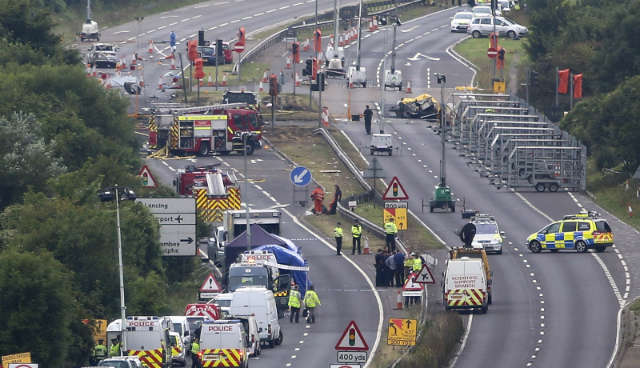A poorly planned and badly executed manoeuvre flown by a display pilot led to the deaths of 11 bystanders and motorists during the Shoreham air show on 22 August 2015, investigators have concluded.
Releasing its final report into the mishap on 3 March, the UK Air Accidents Investigation Branch (AAIB) concluded that the pilot of a vintage Hawker Hunter crashed after commencing a “bent loop” manoeuvre with insufficient speed and engine thrust to complete it within the height available.
According to the pilot’s own display plan, a minimum apex height of 3,500ft was required to execute the aerobatic manoeuvre safely, but investigators found that the Hunter achieved only between an estimated 2,700ft and 2,950ft. Several factors contributed to this, the AAIB says, including it having commenced the move from a lower height – around 185ft, rather than the 500ft mandated for a Hunter – and slower speed than planned.
The aircraft began its climb from 310kt (570km/h); 40kt below the minimum planned value, and “maximum [engine] thrust was not reached or maintained” during the climb, says Julian Firth, the AAIB’s principal investigator. The aircraft’s pilot – who survived the crash – may have not read or misread the jet’s altimeter during the manoeuvre, decided to proceed anyway, or encountered confusion over the required performance of the aircraft involved, investigators suggest.
During post-accident trials conducted in another Hunter by a pilot from the UK Empire Test Pilots’ School, it was determined that the type required at least 2,600ft to perform a straight loop. This activity also found that the pilot of destroyed aircraft G-BXFI could have conducted an effective escape manoeuvre within 4s of reaching its apex with a decayed airspeed of only 105kt; significantly below the targeted 150kt value. However, it found that he had neither prepared for or practiced such a manoeuvre prior to the display sequence.
Another potential factor cited by the AAIB was the pilot’s greater familiarity with the Jet Provost platform, on which he had performed the same manoeuvre at an air show one week earlier. The slower, lighter type enters a bent loop from 200ft and can recover from an apex of around 2,700ft.
Delivering 11 new recommendations to the UK Civil Aviation Authority (CAA) and one to the Department for Transport, the AAIB says display authority procedures for pilots flying multiple types should be reviewed, and that assessment standards should be tightened.
The pilot involved in the Shoreham accident held the required currency to display the Hunter, despite having been recently assessed only in the Jet Provost and turboprop-powered RV-8 for his display authority renewal. Accordingly, the AAIB recommends that pilots be assessed on individual aircraft types during annual renewals, including an assessment of the planning and execution of effective escape manoeuvres during aerobatics.
Additionally, the AAIB investigation identified significant weaknesses in the current arrangements for flight safety committee involvement during air shows, particularly with regard to their inability to halt a display during its progress, or to effectively monitor aircraft heights from the ground. It also notes that the CAA’s monitoring of air displays and pilots’ display authority is not as robust as should be the case. In 2014, CAA personnel performed inspections at only eight out of 281 approved displays in the UK – a figure which rose to just 18 checks at 254 events the following year, including 11 made after the Shoreham accident.

REX/Shutterstock
In response, the CAA states: "The final AAIB report contains a further 10 recommendations for the CAA, all of which we will action as a priority. We are fully committed to ensuring that all air shows take place safely, for the six million people who attend them each year in the UK and for the communities in which they take place."
Other aspects of the investigation highlighted a major failure in safety assessments related to the air show, with no entity having effective responsibility for the safety of members of the public away from the event site itself.
“Measures to protect the public were not effective,” the AAIB notes.
Analysis of the crashed aircraft indicated that shortcomings existed in its maintenance and airworthiness, although this is not believed to have been a factor in the accident sequence.
Source: FlightGlobal.com




















